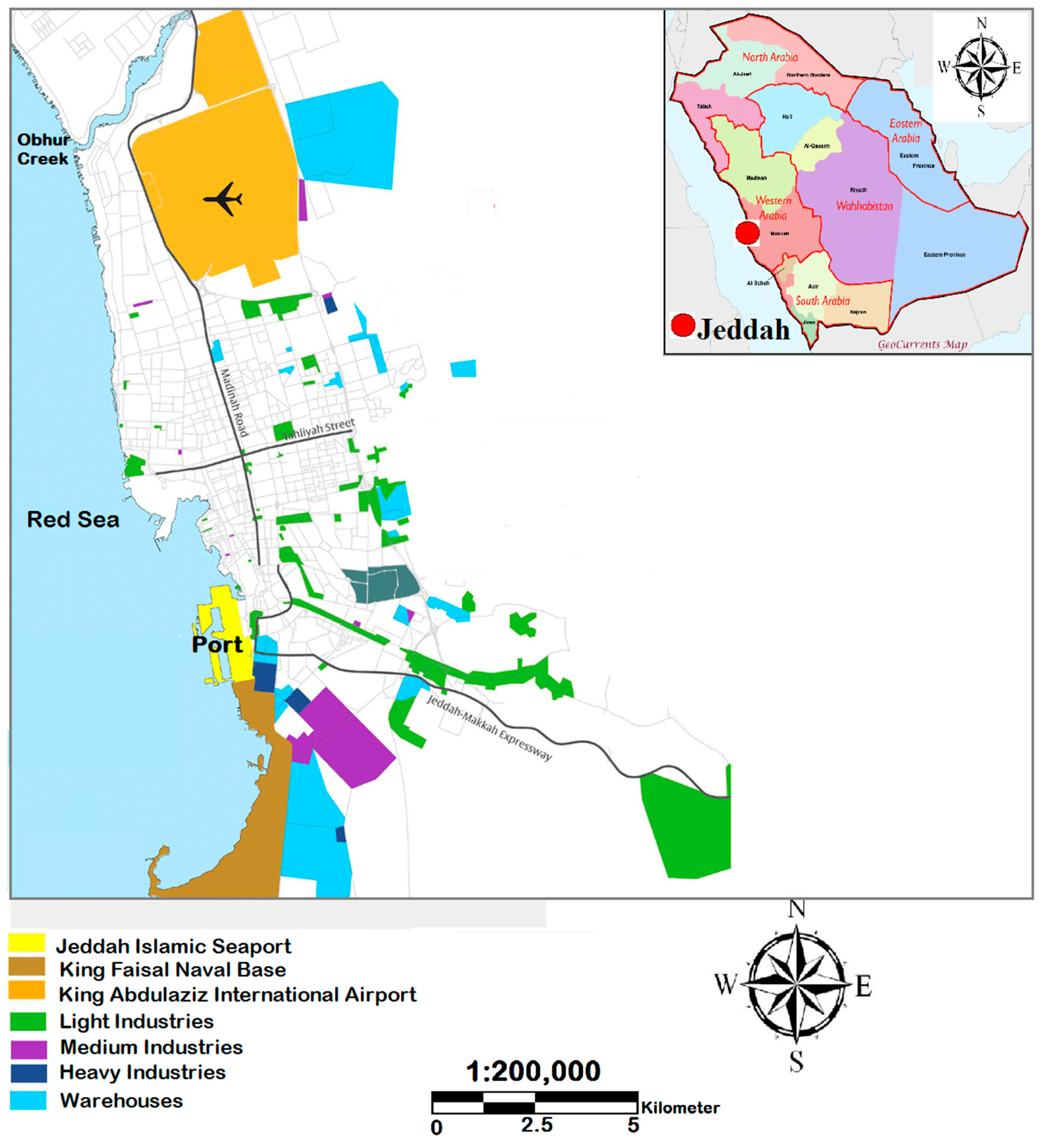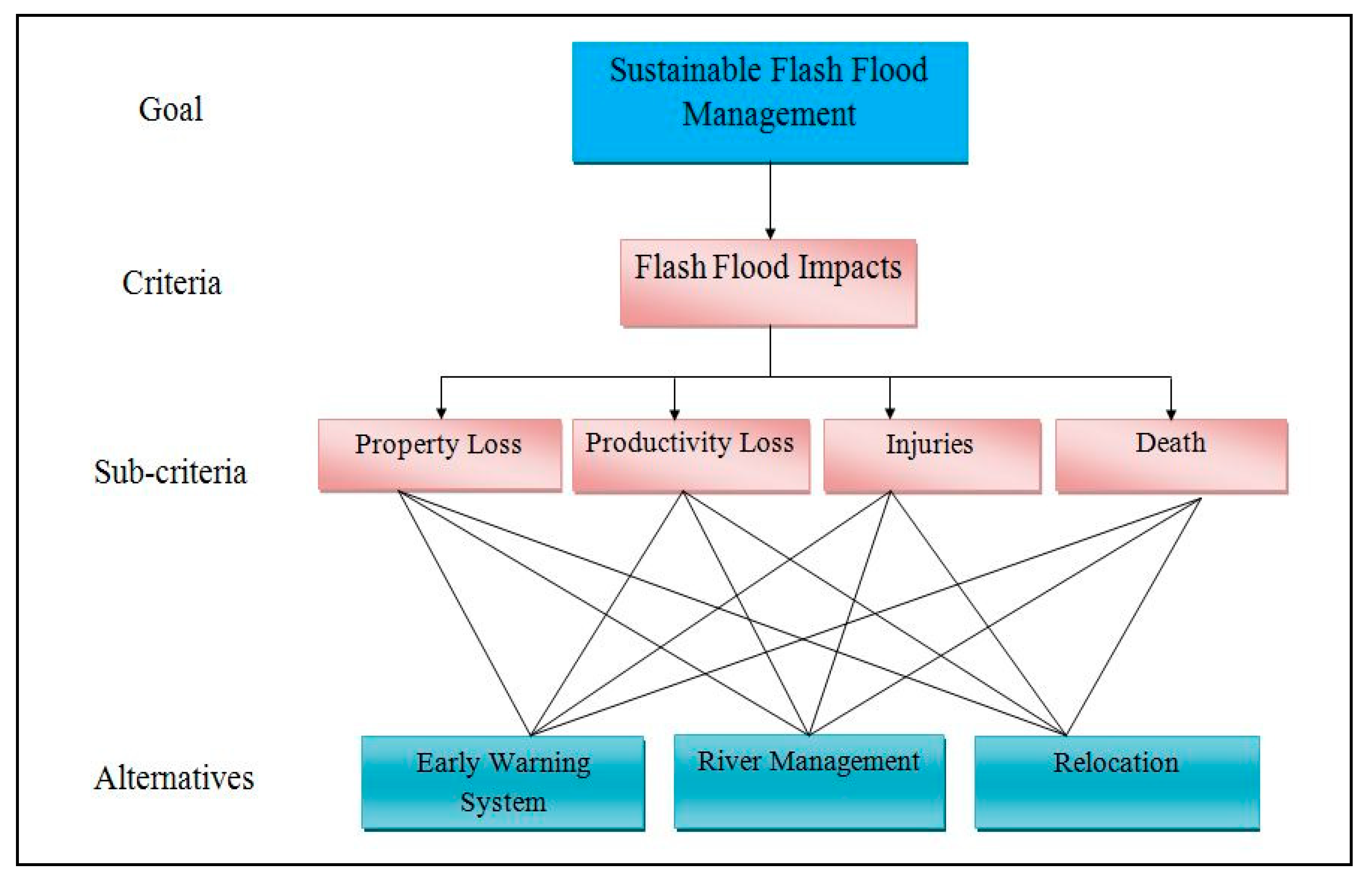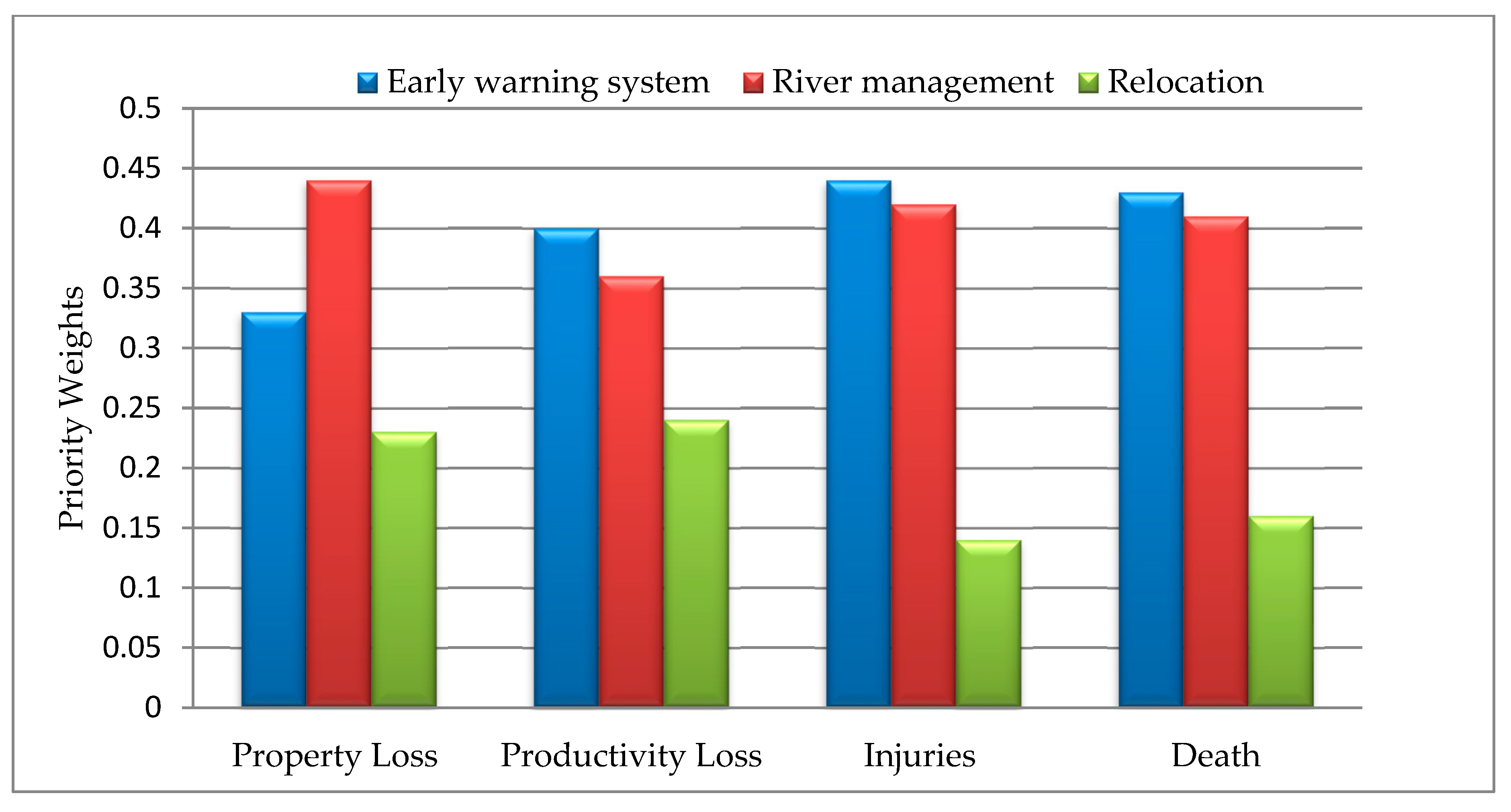1. Introduction
Recent decades have witnessed incessant and immeasurable impacts of floods across the globe. Floods are the most devastating and the costliest of natural disasters that destroy properties, and the lives of millions, accounting for nearly 34% of human loss caused by natural disasters [
1]. Estimates show that between 1995 and 2015, 43% of all the documented natural disasters were caused by floods, disrupting the lives of 2.3 billion people around the globe, causing damages worth USD662 billion, and killing 157,000 people [
2]. By 2050, the number of people susceptible to flooding is expected to reach 2 billion as a result of climate change, rapid population growth in flood-prone areas, deforestation, loss of wetlands, and sea-level rise [
3,
4].
Urban areas are the primary contributors to climate change due to the concentration of major activities that generate greenhouse gas emissions. The proportion of global urban dwellers is anticipated to grow from 54% in 2018 to 68% by 2030, with only African and Asian continents accounting for about 90% of the estimated 2.5 billion rise in urban populations from 2015 to 2050 [
5]. According to an estimate by the World Bank [
6] (p. 15), roughly 70% of the global CO
2 emissions are generated in urban areas, with buildings and transportation being the key contributors. These have triggered global warming and the occurrence of natural disasters such as floods. Thus, urban decision-makers must be the key actors in combating climate change and promoting sustainability [
3]. To help alleviate the devastating impacts of natural hazards, urban development stakeholders are increasingly directing their attention to flood risks and risk reduction alternatives. The Sustainable Development Goal (SDG) number 11, target 5 sets by 2030 to “significantly reduce deaths and economic losses caused by disasters, including water-related disasters” [
5].
Saudi Arabia experiences a series of flood events annually in different parts of the country [
7,
8,
9]. The country’s three largest cities of Jeddah and Dammam located along the coast, and Riyadh encircled by valleys, do experience frequent occurrences of floods in the nation [
10]. Due mainly to geographical (e.g., low elevation) and topographical features (mountains and inadequate slope), as well as other natural and anthropogenic factors, flash floods are the most recurring natural disasters in these areas [
7,
8,
11,
12]. Flash floods occur when rainwater exceeds the absorptive capacity of the drainage basins, subjecting the basin outlets to a sudden high discharge of heavy inflow of water into the environment.
Jeddah city has within the last decade experienced several events of recurring flash floods which have caused human loss and severe damage to road infrastructures, settlements, and economic activities, especially along the floodplains of the Red Sea [
13]. In 2009 and 2011, average damages caused by flash floods in the city cost nearly 10 billion Saudi Riyals (USD 2.6 billion) (USD 1 = 3.75 Saudi Riyals) [
9]. The 2009 event killed 113 people, destroyed 10,000 houses and 17,000 vehicles [
9]. Similarly, the importance of combating floods has been declared by the UN’s SDG 15.3 that called for global efforts to reduce the risks of floods, desertification, and drought to realize a degradation and disaster-free world and to improve the socioeconomic wellbeing of the people. With the recent increases in loss of lives, productivity, and properties resulting from flood disasters worldwide, sustainable flood risks assessment is required. Flood risk assessment is a vital tool for analyzing the likelihood and impacts of flood disasters. It provides useful information to decision-makers and enables them to strategize their responses to mitigate flood disasters. Billa et al. [
14] indicated the urgent need for flood control and prevention measures to minimize the adverse impacts of flooding. The existing flash flood control practices in Jeddah involves (a) small-scale flood controls such as ponds, drainages, and seasonal cleaning and maintaining open channels by the private sectors and individuals; and (b) large-scale flood controls undertaken by the government which includes stormwater drainage and large dams [
15]. However, these approaches are inadequate without an early warning system, which the government is planning to establish for disaster management. As such, experts’ ranking of the relative severity of flood impacts and the most effective approaches to reducing flood risks in Jeddah could provide valuable inputs to more effective design and implementation of the planned warning system.
2. Previous Studies
Several studies have been conducted worldwide on flood hazards and susceptibility mapping, flood monitoring, and flood risk analyses using Multi-Criteria Decision-Making (MCDM) techniques such as Analytic Hierarchy Process (AHP) and Analytic Network Process (ANP). As the MCDM techniques elicit and model experts’ flood preferences, they have several advantages, when it comes to evaluating flood impacts and determining risk mitigation measures, over other flood susceptibility assessment techniques such as probabilistic methods, hydrological and stochastic rainfall techniques, and data mining models that are more suitable for assessing flood causative factors [
16]. Thus, several studies have utilized the MCDM technique in assessing and mapping flood susceptible zones [
17,
18,
19,
20,
21]. Among the MCDM techniques, AHP is the most widely used technique in addressing flood disaster challenges because of its ability to solve a wide range of multiple-criteria decision-making problems using a pairwise comparison matrix to generate priority weights for each decision element [
22,
23,
24,
25,
26,
27].
An AHP is a concept developed by Thomas L. Saaty based on MCDM principles. The concept addresses complex decision-making problems by decomposing them into units and subunits in a hierarchy. It is a mathematical model that analyzes and models complex decision problems through a structured hierarchy technique consisting of an overall goal, cluster of criteria or factors, and a cluster of alternatives or options related to the criteria for achieving the goal. The first stage in developing the hierarchy model is structuring the decision problems into a hierarchical chart, where the decision elements are structured in an interconnected elemental order, with the goal topping the hierarchy, followed by the criteria, sub-criteria, and alternatives at the bottom of the hierarchy.
The AHP approach has been utilized globally in flood risk mapping, susceptibility and impact assessment. In Perlis, Malaysia, Lawal et al. [
28] forecasted areas susceptible to flooding using a group-based AHP and found that rainfall (0.44%), slope gradient (1.67), and geology (1.06) were the highest-ranked flood causative factors by weight. Similarly, Seejata et al. [
29] have utilized AHP to map flood risk-prone districts in Sukhothai province, Thailand, and found that the most weighted factors contributing to flooding were rainfall intensity (4.0), river density (2.6), and slope (1.6). In Rhodope–Evros region of Greece, Kazakis et al. [
30] employed AHP to assess flood hazard areas by estimating the weights of seven parameters with flow accumulation having the highest weight (3.0), followed in equal weight (2.1) by drainage distance and elevation. Additionally, in southeastern Tunisia, Souissi et al. [
27] developed a flood susceptibility map using eight factors with elevation being the most prominent flood occurrence factor (0.23), followed by land use/land cover (0.18). In Abidjan, Cote D’Ivoire, Danumah et al. [
25] used AHP to assess the risk of flooding and found that the highest weighted parameter was slope (4.31) and then rainfall (4.20). Adam [
31] employed AHP in modeling flood hazards based on expert-based and public opinions to prioritize the likely impacts of floods and the efficacy of the available strategies for reducing flood impacts in Makassar city, Indonesia. The literature review above indicates the wider applicability of the AHP method in assessing and mapping flood risk zones. However, the reviewed prior studies are largely limited to exploring flood triggering factors. A notable exception is Adam [
31] who investigated potential flood impacts but merged human loss and injuries as a single variable, despite their different disaster responses and global best practice of reporting [
2]. Therefore, the novelty of the present study is assessing the likely impacts of floods on people and the environment, with a view of identifying the appropriate risk reduction alternatives, which are less investigated in the literature.
In Saudi Arabia, few studies have researched flood risk impacts and the efficacy of mitigation alternatives; however, more attention has been given to human-made disasters such as traffic accidents, fires, and stampedes [
10]. In Riyadh city, Rahman et al. [
11] estimated the extent of the physical and social vulnerability of the residents to flash flooding. The study classified the areas within the city as highly, moderately, and the least vulnerable to flash flooding, as well as the vulnerability of the residents according to income, employment, and nationality. In another study in Riyadh, Ledraa and Al-Ghamdi [
32] investigated the challenges faced by the city administration in flash flood planning and management and recommended a more integrated approach that ensures public participation and good governance. In Makkah area, Subyani [
33] estimates flood triggering hydrological factors in three low-lying areas. A thorough literature search on the application of MCDM techniques in flood assessment in the country yielded only one published article [
34]. Radwan et al. [
34] utilized AHP to assess flood risks in Riyadh city based on soil, geology, rainfall, elevation, and drainage systems data, and categorized the city into very low, low, medium, high, and very high risks zones.
In Jeddah, being a vulnerable city faced with recurrent flash flood hazards, more studies have been conducted compared to other Saudi cities. For instance, Maghrabi [
35] assessed the impacts of flooding on the mental health of flood victims using descriptive statistics. The author found the highly scored impacts were feeling of fear of places and situation (4.43), jumpiness, easily frightened by sound (4.34), and then followed by sleeping problems (3.80). In another study, Haggag and El-Badry [
36] simulated the extreme precipitation that caused the 2009 flash floods in Jeddah. Youssef et al. [
9] utilized statistical methods to assess flash flood susceptibility in Jeddah city using factors such as rainfall, soil, geology, slope, drainage, elevation, and distance from the streams. Tekeli [
37] estimated flood occurrences using three indices developed from rainfall, soil moisture, topography, and land use parameters. Another study by Al Saud [
38] mapped areas that are prone to flash floods based on flood triggering factors: elevation, drainage system, soil type, and human activities. However, these studies mainly address the flood triggering factors with limited focus on the impacts of floods as well as their reduction options.
The above studies mainly assessed flood risk using conventional data such as geological, geomorphological, hydrological, and meteorological data, which mostly require long-term and large data, for example, spatio-temporal data. However, these study methods posed certain challenges of data availability, data scale, incomplete data, and data interpretations [
31]. Certainly, there is the need to complement such studies by employing the opinions of experts in determining flash flood impacts and the efficacy of flood impacts reduction alternatives in the study area. The present study method can serve as a supplementary or an alternative to conventional methods, depending on the study’s objectives. Therefore, to bridge this research gap and contribute to the growing literature on the topic, the present study aims to apply an AHP model to explore the impacts of flash flood hazards and identify the most effective approaches to reducing the flash flood impacts in Jeddah using expert’s opinions. This study is important because it provides an alternative means of measuring flash flood impacts and ranking the effectiveness of flood impact reduction measures based on the MCDM technique.
5. Discussion
The AHP model applied in the current study focused on risk assessment of flash flood hazards in the city of Jeddah. The analysis first assesses the likely impacts of flash flood based on four categories of impacts (property loss, productivity loss, injuries, and death) derived from expert judgments, which vary from that of non-experts such as the public or public agency officials [
10]. Like in the present study, Adam [
31] reported that in Makassar city, property loss has the highest (35.7%) probability of occurrence during flash flood events, followed distantly by productivity loss (1.1%). The findings are in line with what practically takes place as floods damage critical infrastructures such as roads and electricity, water, telecommunication and sewer networks, homes, schools, hospitals, businesses, and so on. In Dammam metropolis of Saudi Arabia, human death and injuries have been rated by the public as the highest impacts of natural hazards, followed by damage to infrastructure and buildings [
10]. Globally, 126 cases of floods have been reported in 2017 that caused 3331 deaths and economic losses worth USD20.3 billion [
1] due largely to rapid urbanization, unplanned urban growth, and climate change [
2,
3].
With respect to flash flood reduction options, river management was adjudged as having the highest (41%) potential of reducing impacts, followed by early warning system (38%) and then relocation (21%). This finding corresponds with that of Adam [
31], where the experts rated river management as the most effective alternative (34.1%) for reducing flash flood impacts, followed by early warning system (13.4%), with relocation being the least (2.5%).
Concerning the efficacy of the three alternatives on reducing the impacts of a flash flood in the study area, early warning system has the highest likelihood (44%) of reducing injuries, followed by death (43%), and productivity loss (40%) more than the two other options. Moreover, some studies conducted on disaster reduction have accentuated the significance of an early warning system in controlling and reducing flood disasters [
56,
57]. Early warning system has been rated by the public as the second most important approach to reducing disaster risks in Dammam metropolis [
10], and in a nationwide study in Saudi Arabia [
58,
59]. This is because an early warning system can save and protect people’s lives, infrastructure, and other amenities [
60]. For this reason, the establishment of an early warning system in flood vulnerable areas will be immensely helpful to reduce the tremendous flood impacts. It enhances the communication between various districts and notifies residents on how to evacuate the disaster risk areas to save lives and properties in advance.
With respect to river management, it has the highest probability of reducing property loss (44%), it is the second-best alternative for reducing injuries (42%), deaths (41%), and productivity loss (36%). These findings are also in line with that of Adam [
31], where river management is the overall best approach for reducing flood impacts. River management is a flood reduction technique that involves dredging (widening or deepening) water channels to allow it to carry more water or increase the flow to divert floodwaters away from settlements. It also involves building a reservoir, riverbank stabilization through the embankment of afforestation, and banning the dumping of garbage into water channels.
Lastly, relocation received the lowest score with respect to reducing all the impacts of a flash flood, compared with the other two alternatives. It has a 24% likelihood of reducing productivity loss, 23% probability of reducing property loss, and 16% likelihood of reducing death, and the least being injuries (14%). In a prior study, relocation has also been judged as the second-least important approach among five alternatives for reducing the risks of natural hazards in Dammam [
10]. This is likely because the tendency for residents to leave their houses or neighborhoods is very low. Similarly, relocation is just a temporary solution to saving lives and belongings; it cannot substantially prevent damages to fixed properties and productivity.
This study approach of using expert-based judgment can provide government and relevant institutions with an alternative option of assessing different risk levels of flood disasters according to their needs and resources. Unlike the public opinion that is influenced by emotions and sentiments, this technique could help address the problems of scientific data accessibility faced by remote areas, especially in developing countries that experience incessant floods. These regions experience limitations in accessing physical data related to slope, land elevation, landforms, water flow and current, water accumulation, and depth, climatology, geology, and so forth, due to several issues including funds, remote locations, technology limitations, and availability of instruments among others.
6. Conclusions
This study explores an alternative technique for assessing flash flood impacts apart from the traditional technique of assessing risk, which is based on the assessment of physical factors such as hydrological, geographical, geological, and hydrogeological parameters among others. The present study underscores the efficacy of the AHP model in assessing flash flood impacts and risk reduction alternatives. The model can help incorporate experts’ judgments in measuring the impacts of flash flooding in cities susceptible to flash flood disasters and rating the different types of flash flood reduction options. Moreover, the study also shows the possibility of measuring the respondent’s risk perception and priority judgments and aggregating them into a collective risk priority using the geometric mean method. Similarly, the model employs the computation of consistency ratio to assess the inconsistency of every single judgment of the respondents. Fundamental implications of the study’s findings include the potentiality of the technique to be applied in any geographical setting. The model could be customized by altering, adding, or eliminating the decision elements in the hierarchy model to suit the flood criteria and characteristics of an area. Besides, the approach, due to its efficiency and effectiveness, can be deployed in several natural disaster assessments such as landslide, drought, earthquake, wildfire, and desertification, among others. Therefore, this study recommends that Jeddah city administrators should utilize the findings of this study as input for better planning of the proposed early warning system towards reducing the impacts of flash flood disaster in the city. The AHP model could help in flash flood management to prevent the loss of lives and properties experienced in an event of a flash flood, minimize the cost expended on the provision of relief packages, as well as a guide against various health hazard and challenges as the aftermath of floods.








